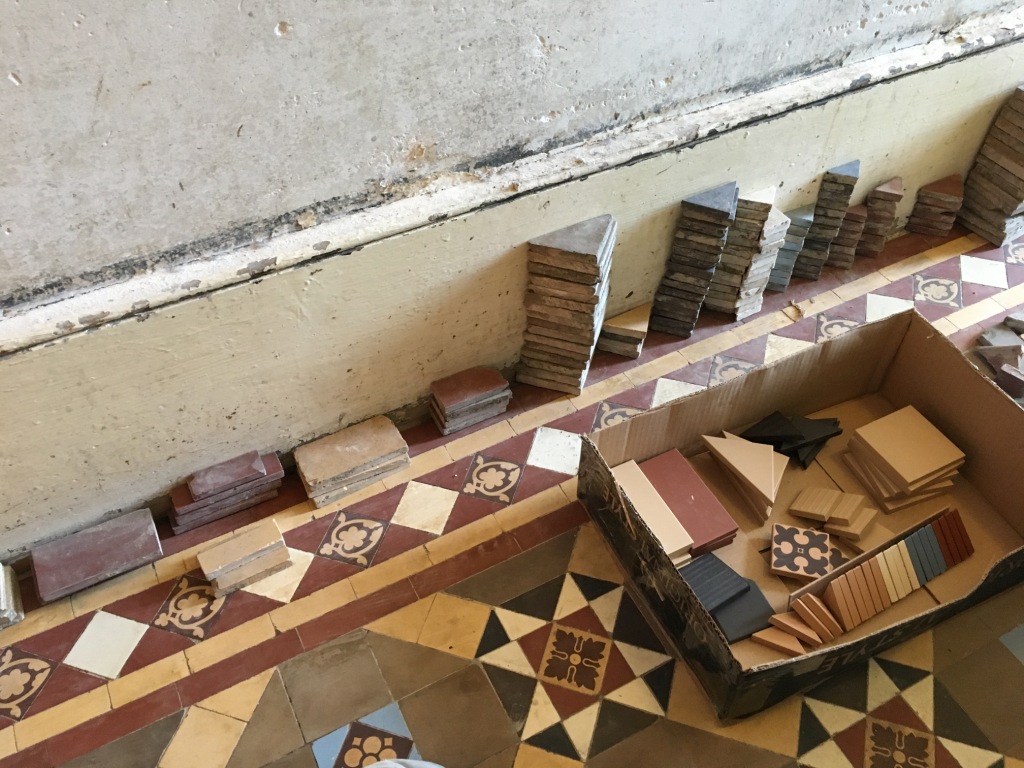Astonishing Victorian Floor Restoration at Weybridge College
I was asked by the facilities manager of St Georges College in Weybridge to survey a Victorian tiled floor for restoration. Having worked there for twenty years he lifted a carpet over the summer in the main reception of the original building as part of renovation work. Underneath he found an original Victorian mosaic tiled floor dating back over a hundred and fifty years to when the school was established. However, for some reason in the distant past they had been partially covered with concrete levelling screed and just to make it more challenging for me the carpet had been secured with adhesive.

After visiting the school to survey the floor I could see this going to be a very challenging job for one person. Fortunately Tile Doctor has a network of over 50 specialists like me all around the Country, so I reached out to neighbouring East Surrey Tile Doctor Mick Conlon who is also very experienced in floor restoration. Together we broke down the job into sections, e.g. remove the adhesive, remove the screed, hone the tiles, repair any missing, broken or damages tiles and finally seal. All in the work would take five days to complete.

Removing Carpet Adhesive from Victorian Floor Tiles
The first task was to smother the surface in Tile Doctor Remove and Go which in turn was covered by plastic sheeting. By trapping the product under a plastic sheet, it couldn’t dry out and thereby remains active for longer.

After a couple of hours, it had broken down the adhesive which we swept up and disposed of. This was unpleasant work which required us to wear protective gloves, masks and goggles.
 |
 |
Removing Cement Screed from Victorian Floor Tiles
On day two we turned our attention to the removal of the concrete screed and cleaning up the tiles. This was done with a process called honing. A circular 200-grit pad was attached to a floor buffer and run over the tiles using water for lubrication. The honing pad is impregnated with industrial diamonds which gradually cuts through and removes the screed covering.

After several hours the tiles began to reveal themselves. It also became apparent that after over 100 years of thousands of pupils walking over them some of the tiles were somewhat dipped in the middle. Using a handheld buffer these areas had extra attention with a very coarse 100-grit diamond pad. This process took most of the day with one man honing whilst the other constantly rinsed the floor with more water and extracted the waste.
Replacing Broken Victorian Floor Tiles
Once the tiles were totally free of concrete screed it exposed several broken and missing tiles. Some tiles had been removed and not replaced but back filled with concrete. Fortunately, I had managed to source matching reclaimed tiles was able to cut and fit replacements. All holes and cracks were filled so the floor was ready for sealing the next day.

Sealing a Victorian Tiled Floor
Given the age of the floor and the high amount of floor traffic this floor would receive I advised against using a high shine sealer and recommended an impregnating breathable matt sealer instead. There were two main reasons for this, first old floors don’t have a damp-proof membrane installed so it’s important to use a sealer that will allow the floor to breath and allow moisture to rise through the tiles. Secondly, only an impregnating sealer which soaks into the pores of the tile would cope with the anticipated heavy footfall.

With that agreed several coats of Tile Doctor Colour Grow sealer were applied to the tiles leaving the floor looking great and completely transformed. At end of the last day the headmistress came to give her approval as did the whole secretarial staff. My favourite word was “astonishing”. Hard to disagree.

Professional Restoration of a Victorian Tiled College Hallway in Surrey
Astonishing Victorian Floor Restoration at Weybridge College Read More »


















